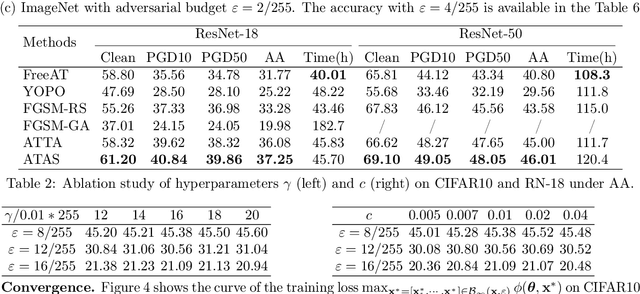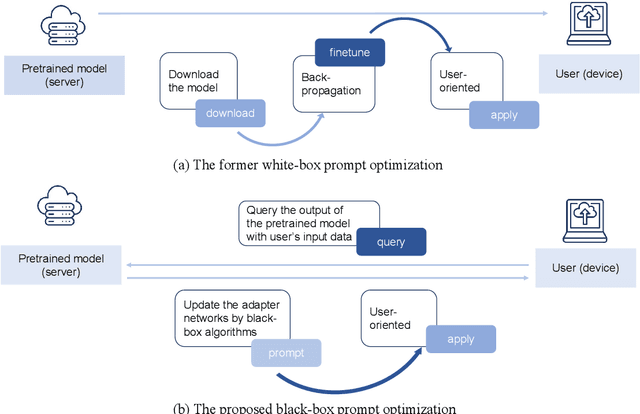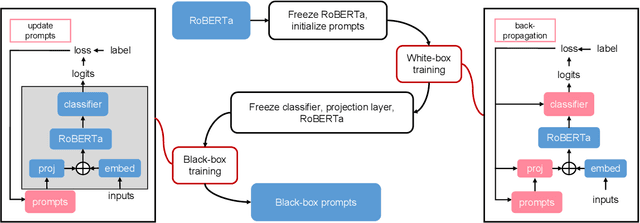Zhichao Huang
Nested Graph Pseudo-Label Refinement for Noisy Label Domain Adaptation Learning
Aug 01, 2025Abstract:Graph Domain Adaptation (GDA) facilitates knowledge transfer from labeled source graphs to unlabeled target graphs by learning domain-invariant representations, which is essential in applications such as molecular property prediction and social network analysis. However, most existing GDA methods rely on the assumption of clean source labels, which rarely holds in real-world scenarios where annotation noise is pervasive. This label noise severely impairs feature alignment and degrades adaptation performance under domain shifts. To address this challenge, we propose Nested Graph Pseudo-Label Refinement (NeGPR), a novel framework tailored for graph-level domain adaptation with noisy labels. NeGPR first pretrains dual branches, i.e., semantic and topology branches, by enforcing neighborhood consistency in the feature space, thereby reducing the influence of noisy supervision. To bridge domain gaps, NeGPR employs a nested refinement mechanism in which one branch selects high-confidence target samples to guide the adaptation of the other, enabling progressive cross-domain learning. Furthermore, since pseudo-labels may still contain noise and the pre-trained branches are already overfitted to the noisy labels in the source domain, NeGPR incorporates a noise-aware regularization strategy. This regularization is theoretically proven to mitigate the adverse effects of pseudo-label noise, even under the presence of source overfitting, thus enhancing the robustness of the adaptation process. Extensive experiments on benchmark datasets demonstrate that NeGPR consistently outperforms state-of-the-art methods under severe label noise, achieving gains of up to 12.7% in accuracy.
Seed LiveInterpret 2.0: End-to-end Simultaneous Speech-to-speech Translation with Your Voice
Jul 24, 2025



Abstract:Simultaneous Interpretation (SI) represents one of the most daunting frontiers in the translation industry, with product-level automatic systems long plagued by intractable challenges: subpar transcription and translation quality, lack of real-time speech generation, multi-speaker confusion, and translated speech inflation, especially in long-form discourses. In this study, we introduce Seed-LiveInterpret 2.0, an end-to-end SI model that delivers high-fidelity, ultra-low-latency speech-to-speech generation with voice cloning capabilities. As a fully operational product-level solution, Seed-LiveInterpret 2.0 tackles these challenges head-on through our novel duplex speech-to-speech understanding-generating framework. Experimental results demonstrate that through large-scale pretraining and reinforcement learning, the model achieves a significantly better balance between translation accuracy and latency, validated by human interpreters to exceed 70% correctness in complex scenarios. Notably, Seed-LiveInterpret 2.0 outperforms commercial SI solutions by significant margins in translation quality, while slashing the average latency of cloned speech from nearly 10 seconds to a near-real-time 3 seconds, which is around a near 70% reduction that drastically enhances practical usability.
SeqPO-SiMT: Sequential Policy Optimization for Simultaneous Machine Translation
May 27, 2025



Abstract:We present Sequential Policy Optimization for Simultaneous Machine Translation (SeqPO-SiMT), a new policy optimization framework that defines the simultaneous machine translation (SiMT) task as a sequential decision making problem, incorporating a tailored reward to enhance translation quality while reducing latency. In contrast to popular Reinforcement Learning from Human Feedback (RLHF) methods, such as PPO and DPO, which are typically applied in single-step tasks, SeqPO-SiMT effectively tackles the multi-step SiMT task. This intuitive framework allows the SiMT LLMs to simulate and refine the SiMT process using a tailored reward. We conduct experiments on six datasets from diverse domains for En to Zh and Zh to En SiMT tasks, demonstrating that SeqPO-SiMT consistently achieves significantly higher translation quality with lower latency. In particular, SeqPO-SiMT outperforms the supervised fine-tuning (SFT) model by 1.13 points in COMET, while reducing the Average Lagging by 6.17 in the NEWSTEST2021 En to Zh dataset. While SiMT operates with far less context than offline translation, the SiMT results of SeqPO-SiMT on 7B LLM surprisingly rival the offline translation of high-performing LLMs, including Qwen-2.5-7B-Instruct and LLaMA-3-8B-Instruct.
Towards Achieving Human Parity on End-to-end Simultaneous Speech Translation via LLM Agent
Jul 31, 2024



Abstract:In this paper, we present Cross Language Agent -- Simultaneous Interpretation, CLASI, a high-quality and human-like Simultaneous Speech Translation (SiST) System. Inspired by professional human interpreters, we utilize a novel data-driven read-write strategy to balance the translation quality and latency. To address the challenge of translating in-domain terminologies, CLASI employs a multi-modal retrieving module to obtain relevant information to augment the translation. Supported by LLMs, our approach can generate error-tolerated translation by considering the input audio, historical context, and retrieved information. Experimental results show that our system outperforms other systems by significant margins. Aligned with professional human interpreters, we evaluate CLASI with a better human evaluation metric, valid information proportion (VIP), which measures the amount of information that can be successfully conveyed to the listeners. In the real-world scenarios, where the speeches are often disfluent, informal, and unclear, CLASI achieves VIP of 81.3% and 78.0% for Chinese-to-English and English-to-Chinese translation directions, respectively. In contrast, state-of-the-art commercial or open-source systems only achieve 35.4% and 41.6%. On the extremely hard dataset, where other systems achieve under 13% VIP, CLASI can still achieve 70% VIP.
Core Knowledge Learning Framework for Graph Adaptation and Scalability Learning
Jul 02, 2024



Abstract:Graph classification is a pivotal challenge in machine learning, especially within the realm of graph-based data, given its importance in numerous real-world applications such as social network analysis, recommendation systems, and bioinformatics. Despite its significance, graph classification faces several hurdles, including adapting to diverse prediction tasks, training across multiple target domains, and handling small-sample prediction scenarios. Current methods often tackle these challenges individually, leading to fragmented solutions that lack a holistic approach to the overarching problem. In this paper, we propose an algorithm aimed at addressing the aforementioned challenges. By incorporating insights from various types of tasks, our method aims to enhance adaptability, scalability, and generalizability in graph classification. Motivated by the recognition that the underlying subgraph plays a crucial role in GNN prediction, while the remainder is task-irrelevant, we introduce the Core Knowledge Learning (\method{}) framework for graph adaptation and scalability learning. \method{} comprises several key modules, including the core subgraph knowledge submodule, graph domain adaptation module, and few-shot learning module for downstream tasks. Each module is tailored to tackle specific challenges in graph classification, such as domain shift, label inconsistencies, and data scarcity. By learning the core subgraph of the entire graph, we focus on the most pertinent features for task relevance. Consequently, our method offers benefits such as improved model performance, increased domain adaptability, and enhanced robustness to domain variations. Experimental results demonstrate significant performance enhancements achieved by our method compared to state-of-the-art approaches.
EDDA: A Encoder-Decoder Data Augmentation Framework for Zero-Shot Stance Detection
Mar 23, 2024



Abstract:Stance detection aims to determine the attitude expressed in text towards a given target. Zero-shot stance detection (ZSSD) has emerged to classify stances towards unseen targets during inference. Recent data augmentation techniques for ZSSD increase transferable knowledge between targets through text or target augmentation. However, these methods exhibit limitations. Target augmentation lacks logical connections between generated targets and source text, while text augmentation relies solely on training data, resulting in insufficient generalization. To address these issues, we propose an encoder-decoder data augmentation (EDDA) framework. The encoder leverages large language models and chain-of-thought prompting to summarize texts into target-specific if-then rationales, establishing logical relationships. The decoder generates new samples based on these expressions using a semantic correlation word replacement strategy to increase syntactic diversity. We also analyze the generated expressions to develop a rationale-enhanced network that fully utilizes the augmented data. Experiments on benchmark datasets demonstrate our approach substantially improves over state-of-the-art ZSSD techniques. The proposed EDDA framework increases semantic relevance and syntactic variety in augmented texts while enabling interpretable rationale-based learning.
Speech Translation with Large Language Models: An Industrial Practice
Dec 21, 2023



Abstract:Given the great success of large language models (LLMs) across various tasks, in this paper, we introduce LLM-ST, a novel and effective speech translation model constructed upon a pre-trained LLM. By integrating the large language model (LLM) with a speech encoder and employing multi-task instruction tuning, LLM-ST can produce accurate timestamped transcriptions and translations, even from long audio inputs. Furthermore, our findings indicate that the implementation of Chain-of-Thought (CoT) prompting can yield advantages in the context of LLM-ST. Through rigorous experimentation on English and Chinese datasets, we showcase the exceptional performance of LLM-ST, establishing a new benchmark in the field of speech translation. Demo: https://speechtranslation.github.io/llm-st/.
RepCodec: A Speech Representation Codec for Speech Tokenization
Aug 31, 2023



Abstract:With recent rapid growth of large language models (LLMs), discrete speech tokenization has played an important role for injecting speech into LLMs. However, this discretization gives rise to a loss of information, consequently impairing overall performance. To improve the performance of these discrete speech tokens, we present RepCodec, a novel speech representation codec for semantic speech tokenization. In contrast to audio codecs which reconstruct the raw audio, RepCodec learns a vector quantization codebook through reconstructing speech representations from speech encoders like HuBERT or data2vec. Together, the speech encoder, the codec encoder and the vector quantization codebook form a pipeline for converting speech waveforms into semantic tokens. The extensive experiments illustrate that RepCodec, by virtue of its enhanced information retention capacity, significantly outperforms the widely used k-means clustering approach in both speech understanding and generation. Furthermore, this superiority extends across various speech encoders and languages, affirming the robustness of RepCodec. We believe our method can facilitate large language modeling research on speech processing.
Fast Adversarial Training with Adaptive Step Size
Jun 06, 2022



Abstract:While adversarial training and its variants have shown to be the most effective algorithms to defend against adversarial attacks, their extremely slow training process makes it hard to scale to large datasets like ImageNet. The key idea of recent works to accelerate adversarial training is to substitute multi-step attacks (e.g., PGD) with single-step attacks (e.g., FGSM). However, these single-step methods suffer from catastrophic overfitting, where the accuracy against PGD attack suddenly drops to nearly 0% during training, destroying the robustness of the networks. In this work, we study the phenomenon from the perspective of training instances. We show that catastrophic overfitting is instance-dependent and fitting instances with larger gradient norm is more likely to cause catastrophic overfitting. Based on our findings, we propose a simple but effective method, Adversarial Training with Adaptive Step size (ATAS). ATAS learns an instancewise adaptive step size that is inversely proportional to its gradient norm. The theoretical analysis shows that ATAS converges faster than the commonly adopted non-adaptive counterparts. Empirically, ATAS consistently mitigates catastrophic overfitting and achieves higher robust accuracy on CIFAR10, CIFAR100 and ImageNet when evaluated on various adversarial budgets.
Black-box Prompt Learning for Pre-trained Language Models
Jan 21, 2022



Abstract:Domain-specific fine-tuning strategies for large pre-trained models received vast attention in recent years. In previously studied settings, the model architectures and parameters are tunable or at least visible, which we refer to as white-box settings. This work considers a new scenario, where we do not have access to a pre-trained model, except for its outputs given inputs, and we call this problem black-box fine-tuning. To illustrate our approach, we first introduce the black-box setting formally on text classification, where the pre-trained model is not only frozen but also invisible. We then propose our solution black-box prompt, a new technique in the prompt-learning family, which can leverage the knowledge learned by pre-trained models from the pre-training corpus. Our experiments demonstrate that the proposed method achieved the state-of-the-art performance on eight datasets. Further analyses on different human-designed objectives, prompt lengths, and intuitive explanations demonstrate the robustness and flexibility of our method.
 Add to Chrome
Add to Chrome Add to Firefox
Add to Firefox Add to Edge
Add to Edge